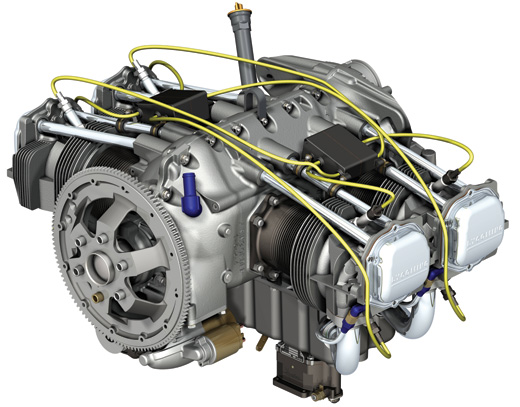
A CAD drawing of the ultimate O-233 LSA engine shows an alternative placement of the ignition coils and the reduced-weight “relieved” starter ring gear.
Looks, they say, can be deceiving. Stroll casually past Lycoming’s new O-233 engine, and you’d easily dismiss it. Yep, that’s an O-235, good little engine. Had one in the front of the Cessna I trained in…no big deal.
Hold on, there. What you’re seeing is actually Lycoming’s big push into the Light Sport Aircraft market, an aggressive program aimed at stemming the flow of Rotax 912s and Continental O-200s into both factory-built SLSAs and Experimental/Amateur-Built designs. And it’s not a matter of slapping a new data plate onto an existing engine and turning up the heat on the production line. Instead, Lycoming has expended considerable engineering resources on this little engine. It will have to certify it to the ASTM consensus standards and, later, to the FAA’s FAR Part 33 powerplant standards. So much is new that the old type certificate won’t work.
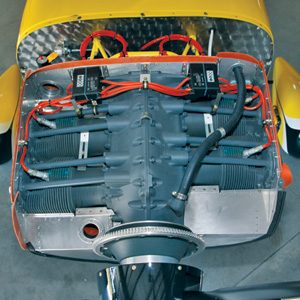
Lycoming’s O-233 appears similar to the venerable O-235 but it’s significantly changed.
Weighty Issues
Lycoming’s big push for the 233 centered on weight reduction—aiming for 233 pounds dry. A bit of history is necessary here. Lycoming’s natural competitors in the LSA market are the Rotax 912 and 912S along with the Continental O-200. Other engines are making headway as well, including the new UL Power four-cylinder, air-cooled engine. The Rotax is a comparatively new design, scaled up from the Austrian company’s experience with two-stroke aero engines and four-stroke powerplants for the so-called powersports industry (motorcycles, ATVs, watercraft, snowmobiles).
As general aviation reformed after WW-II, the flat engine ascended to prominence. From Continental came the A- and then C-series engines, four-cylinder, lightweight, modestly powerful (65 to 90 horsepower) designs perfect for the light aircraft of the time. Lycoming followed suit with its own line of flat-four engines, and actually certified a powerplant called the O-233 in 1940 but did not pursue production of it. Instead, the Williamsport, Pennsylvania company pushed ahead with other flat-four designs, which, like those from rival Continental, quickly moved from flat-head to overhead-valve designs and fueled the GA boom in postwar America.
During that period, Continental preferred small sixes to move up the power chart, while Lycoming stuck with ever greater displacement in its fours. Lycoming did not develop the original O-233 but crafted the O-235 instead, certifying it in 1942. It was intended as part of a building-block format for future engines. To get 233 cubic inches, the 235 has a 4.375-inch bore and a 3.875-inch stroke. Soon the O-235 was joined by the O-290 (same stroke but now a 4.875-inch bore), and a new line of engines based on larger but still parallel-valve cylinders emerged as the O-320 (5.125-inch bore and 3.875-inch stroke) and O-360 (5.125-inch bore and 4.375-inch stroke). From the start, Lycoming intended to leapfrog Continental on the small-fours front by giving the O-235 more displacement and the potential for more power than the four-cylinder C-series engines that would become, ultimately, the O-200 series. Where the O-200 topped out at 100 hp, Lycoming’s little gray engine could produce between 108 and 125 hp, variable by compression ratio, detail engine specifications and maximum allowable rpm. But the offset to the extra power was weight. According to Lycoming’s data, the basic O-235 weighs between 243 and 255 pounds dry. That’s spotting almost 50 pounds on the small Continental.
Into a world of ever-growing aircraft unfettered by an arbitrary maximum-gross-weight limit, the 235 succeeded, powering almost every popular two-seat trainer of the 1960s and 1970s, finally making it into the Cessna 152 for 1978. The O-235s were everywhere, earning a reputation for durability and resistance to carburetor icing—a large issue on the O-200, whose carburetor did not benefit from being bolted to a warm oil sump—and could provide the extra oomph needed as these basic designs evolved into heavier, better-equipped aircraft. In this context, the extra pounds of the 235 weren’t a big issue; the extra power provided better takeoff and climb performance, which allowed airframe manufacturers to increase gross weight, sometimes by more than the extra engine weight. Win-win.
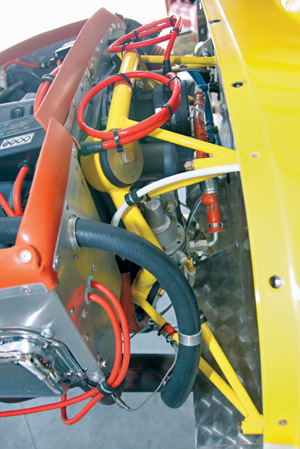
Lycoming simplified the O-233’s accessory case, which in turn allows the engine to be mounted closer to the firewall.
LSA = Diet Time
With landplane versions of LSA limited to 1320 pounds, engine weight suddenly became an issue, especially with the Rotax 912 weighing a feathery 125 pounds dry (and about 140 to 155 installed, with all systems and fluids). Continental revamped the already smaller and lighter O-200 to squeak in below 200 pounds, and getting close was the goal for the O-233. Incidentally, the change in nomenclature more accurately reflects the engine’s true displacement but is also handy for differentiating it from the O-235, which remains in production.
To achieve the weight-loss goals, Lycoming’s engineering staff, headed by Guido Defever (Lycoming’s VP of Research, Development and Engineering) and Ken Bear (the O-233 program manager) looked at every aspect of the engine, and scrutinized every piece for possible weight savings. The engineers started by reducing the weight of the crankshaft and connecting rods using modern design tools. They found a few ounces here and there, but were reluctant to dramatically alter the bottom end of an engine that has proven itself over tens of thousands of flight hours. The cylinders are essentially O-235 items with tapered fins on the steel barrels. The parallel-valve heads use the same castings as the 235 and the same valves. Compression ratios run from 8.1:1 to 8.5:1.
Surrounding that crankshaft are engine cases strategically lightened. Beneath the main crankcase castings is a revised oil sump that further trims the dry weight of the engine. As with the O-235, the main induction spider is contained within the sump, and the carburetor or fuel-injection servo bolts right to the sump. Spinning in its traditional location above the crankshaft is a new camshaft with improved flat-face tappets now featuring hydraulic lash adjustment. The O-235 is a solid-tappet engine, meaning you have to adjust valve clearances periodically. For reasons of weight and cost, Lycoming elected to remain with flat tappets even as the rest of the lineup has migrated to rolling-element followers to offer reduced friction and the likelihood that lifter spalling will remain in Lycoming’s past. Lycoming is looking at a different style of flat tappet developed as part of its air-racing efforts.
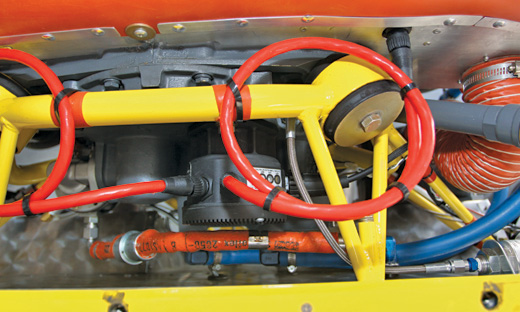
Champion’s simplified electronic ignition includes an internal power supply and fixed timing. Its big benefit is reduced weight over magnetos.
Accessory to Weight Loss
Lycoming found a big chunk of fat hanging from the back of the engine, and took a sharp knife to it during the 233’s development. A completely new accessory case trades dual magneto pads (and their associated, heavy steel gears) for a single portal filled with a Champion-built electronic ignition.
Simplifying the accessory case and omitting a few gears not only reduced weight but allowed for a shallower accessory case, which in turn permits the engine to be placed closer to the firewall. Even if the 233 came out heavier than the O-200, it could be moved aft in the airframe to reduce its impact on the overall center of gravity.
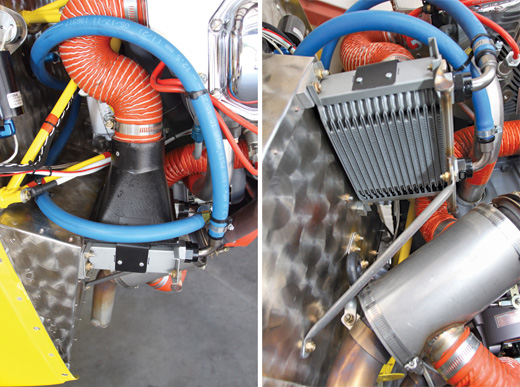
In the Kitfox Super Sport installation, the Lycoming O-233 operates more happily with an oil cooler.
At the same time Lycoming is working to perfect its IE2 full-authority digital engine controls (FADEC) on the larger engines, it took a conservative tack with the 233. As mentioned, the electronic ignition featured here uses a single module bolted to the back of the engine. Inside the finned housing are analog circuits managing ignition timing as well as a permanent-magnet generator. In use, the Champion system runs on internal power except for starting and in the event of an internal generator failure. The installation requires connection to ship’s power for starting and backup power, and a small light on the instrument panel alerts the pilot when the system is in reversion mode.
Fancy multi-level, possibly fuel-saving ignition curves inside? Ah, no. The box maintains timing at TDC (top dead center) for starting and ramps up to the desired advance while the engine reaches idle speed. And there it sits, commanding the pair of coils to kick out a fixed-timing spark regardless of rpm or manifold pressure. Again, simplicity and low cost were driving factors. Lycoming judged the small performance gain from variable timing to be more than offset by the benefits. Swapping the Champion system for a pair of even lightweight mags stripped 6 pounds from the engine. Moreover, in today’s cash-strapped FAA world, shepherding certification of any critical component carrying actual computer software can be a long, difficult experience, one Lycoming wanted to avoid; the Champion system is an analog animal, much more palatable to the FAA.
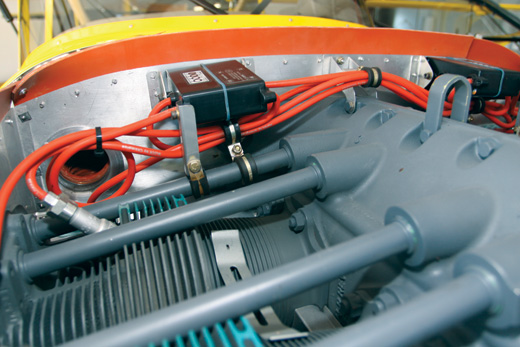
Twin coil packs are small enough to mount in a variety of locations. Kitfox decided to mount them along the baffle on the cooler side of the engine compartment.
Developer Solutions
You may recall seeing an unusual “relieved” starter ring gear on the O-233 originally shown to the public. Those slots were cut to save weight, of course, but not as obvious was the choice of magnesium for the material. After all, the starter ring gear is just dead weight once the engine is running, so it was an early target. The engine in the Kitfox Series 7 Super Sport we flew (See Kitfox Super Sport) has a standard ring gear to comply with an interim service bulletin. Seems after comprehensive durability testing—known inside most engineering departments as “beating the crap” out of stuff—the slotted magnesium part didn’t hold up. Lycoming will return to the relieved item, just in a different material.
A vague recollection that Lycoming called this engine an IO-233 at its introduction isn’t early onset dementia. It did, and pushed through initial testing of a simplified throttle-body injection scheme. Here, fuel is injected right at the throttle body rather than into the intake ports through an injector screwed into the cylinder head. Only it didn’t work. “We found that system was sensitive to setup and needed to be adjusted with big changes in climate,” said Lycoming’s Bear. “Flight schools wouldn’t put up with that.” So, for now, this system has been abandoned in favor of a Marvel-style carburetor. For users in the Experimental category, a version of the IO-233 can be purchased through Lycoming’s Thunderbolt program that features your choice of Airflow Performance or Precision Airmotive injection schemes. For now, though, injection is not on the menu for LSA customers.
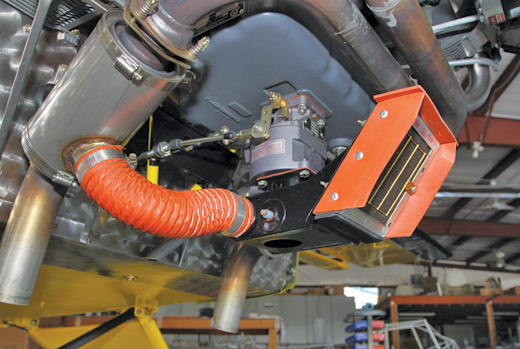
Lycoming has, for now, abandoned the single-point fuel injection for the ASTM-approved engines; a Volare carburetor will be the standard fitment.
Pulp Nonfiction
In late October 2011, Lycoming was nearing the end of the ASTM approval process, which would allow use of the engine in factory-built SLSAs, and was compiling the data it needs to commit FAA certification as well. “We’re currently working on the ASTM approval with an initial TBO (time between overhauls) of 1000 hours, but we’re doing the testing now to increase that eventually to the same TBO as the O-235, 2400 hours,” says Bear. “We expect that to be finished by the first quarter of 2012.” The reason? ASTM standards require actual tests to determine component wear that underpin the TBO determination. “The ASTM has taken the FAA’s FARs and condensed them down into about three and a half pages. It seems like it would make it easier, but it doesn’t. What’s different from the FARs is the requirements for stating a TBO. There is a specific amount of engine durability testing that has to be completed,” says Bear. For certified engines, there is no test for TBO. Instead, it’s a manufacturer recommendation based on a combination of in-house durability testing and fleet experience in the field.
Lycoming was eager to seek ASTM approval for the engine in part to take advantage of the streamlined testing process. Says Marolous Cebulka, OEM sales manager, “On the ASTM path, you can move quicker because the rules are outlined, and there’s no FAA oversight interjected or mandated. It’s a self-declaration. We have done extensive company testing to build confidence in the engine to the degree that where we are today, all we need is to run the engine in a set program to [validate] the 2400-hour TBO. It is a little different from what you would do on an FAA certification run, but now we really just have to execute the tests.”
So, will the O-233 be competitive? In certain aircraft, the answer is yes. Bear in mind that the 233’s installed weight of 220 pounds is more than some very light LSAs can manage, particularly those that have grown out of European microlights. But for larger designs, like the Kitfox, it’s a natural fit. Lycoming understands the challenge, and has included one more carrot: At the 115-hp level, the O-233 can use approved unleaded auto fuels (basically premium unleaded without ethanol), the same gas that the Rotax 912 actually prefers. Lycoming has obviously looked at the operating conditions of the most popular LSAs and made considerable effort toward slotting the 233 into that role as smoothly as possible.
For more information, call 577/323-6181, or visit www.lycoming.com.

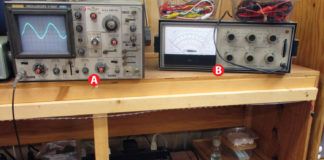
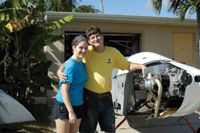
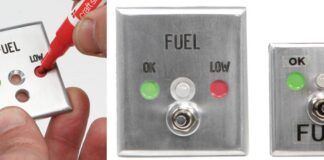
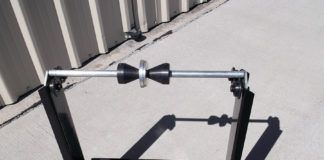
Always enjoy stories on new products but you rarely add one of the most important things. Prices.
I understand different agents may quote slightly different prices so you could quote ‘around’ x-dollars. Many thanks